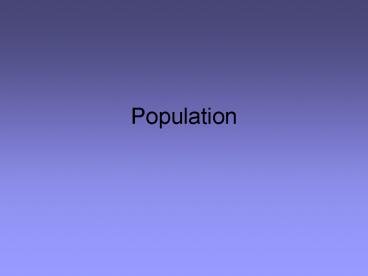Population - PowerPoint PPT Presentation
1 / 35
Title:
Population
Description:
Population What about those big bad diseases? Let natural selection remove the Joe Sixpacks: Final Exam Times MWF 10:30-11:20 class: Monday, December 7th, 10:10-11:50 ... – PowerPoint PPT presentation
Number of Views:176
Avg rating:3.0/5.0
Title: Population
1
Population
2
Final Exam Times
- MWF 1030-1120 class
- Monday, December 7th, 1010-1150
- MWF, 1130-1220 class
- Wednesday, December 9th, 1010-1150
3
How do populations grow?
Population
Deaths
Births
Immigration
Emigration
4
Population Growth Models
- Linearprobably not realistic
- Exponential (geometric) dN/dt rN
- rintrinsic rate of increase(b-d)
- Npopulation size
- Logistic dN/dt rN (K-N/K)
- Includes carrying capacity term (K-N/K) or
(1-(N/K)) - More realistic due to environmental factors
- Others with competition, stage-based (age or size
specific), etc.
5
Geometric or Exponential Growth
Phlox drummondii
6
Anatomy of the Exponential Growth Model
7
Another example of exponential growth whooping
cranes
8
Logistic Growth (includes carrying capacity term)
Yeast
African Buffalo
9
A word about your projects the MORE formula
- You need to be motivated. This means that you
need to keep in touch with other people in your
group and other important people like Jeff Aker
and plant operations folk. - You need to be organized. Make sure you know who
is doing what and when and where (and why and
how). - You need to be responsible. Make sure you know
what is expected and that you complete the
expected work. No more hand-holding. - Be an elephant
10
What determines limits to Population Growth?
- Density-dependentbiotic factors like disease,
competition, or predation - Density-independentabiotic factors like climate,
fire, nutrients, sunlight, etc.
11
Galapagos Islands
- Darwin studied in 1830s
- Found some birds he thought were unrelated
- In fact, they were closely related finches in
different species
12
Adaptive Radiation Galapagos Finches
13
To quote Darwin
- "It is very remarkable that a nearly perfect
gradation of structure in this one group can be
traced in the form of the beak, from one
exceeding in dimensions that of the largest
gros-beak, to another differing but little from
that of a warbler."
14
Environment Varies Leading to Density independent
regulation of population
15
Medium Ground Finch benefits from increased
rainfall
El Nino Year
16
El Nino Year
17
Cactus Finches
- Eat flower pollen from buds
- Eat seeds
- Drink nectar
- Eat insects
- Some seed dispersal
- Some pollination
18
Opuntia helleri prickly pear cactus
- El Nino damaged them by water-logging and salt
spray (density independent factors) - Damage is also by competition from other plants
and cactus finches (density dependent factors)
19
Cactus flower abundance and damage by cactus
finches
20
Survivorship curves (from chapter 10)
21
r vs. K-selection
- r-selected
- K-selected
- Small size
- Many offspring
- Cheap to produce
- Little investment in offspring
- Type III survivorship curve
- Early and one-time reproduction
- Large size
- Few offspring
- Expensive to produce
- Much investment in offspring
- Type I survivorship curve
- Later and repetitive reproduction
22
r vs. K-selection
23
Human Population Growth
LOOK!! Humans are subject to carrying capacity,
too!!
- Expected to reach 9.5 billion or so by 2050
- Most of this in developing countries
24
Trends in human population growth
- 1800 1 billion
- 1930 2 billion
- 1960 3 billion
- 1975 4 billion
- 1987 5 billion
- 1999 6 billion
- Current 6.8 billion
25
Human Population Growth
- 3 Revolutions
- Agricultural 10,000 ybp
- Industrial 225 ybp
- Medical/technological 50 ybp
26
Age-Sex Pyramids developed vs. developing
nations
27
The Demographic Transition
28
The Impact of Epidemics
29
With and without AIDS
30
Do big diseases make a difference?
31
U.S. Population
32
(No Transcript)
33
(No Transcript)
34
What about those big bad diseases?
35
Let natural selection remove the Joe Sixpacks































